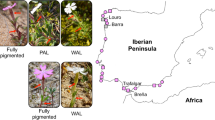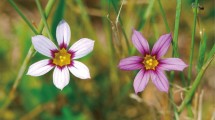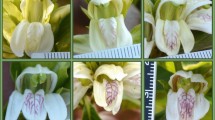Abstract
Understanding the genetics of a polymorphic trait is important to predict its likely evolution. In Collinsia heterophylla, the upper petal lip colour can be either be white or white with a purple band, while the lower petal lip colour is invariably purple. Because the corolla is only partly polymorphic, the polymorphism can not have evolved due to a mutation where a pigment was lost in the entire plant, which is common in other polymorphic species. In a previous study, high frequency of the purple band was found in populations with darker flowers, indicating possible selection for this trait. In this study, I determined inheritance of the colour polymorphism using two populations (one with only white morph and other with both morphs). I conducted experimental crosses within and between floral morphs to determine whether patterns of segregation in offspring conform to single-gene predictions. Data from F1, F2, F3 and backcross progeny are consistent with a genetic model of one major locus with presence of the band being completely dominant, as indicated in earlier studies using distantly related populations. A novel finding in this study was that the two morphs did not show a difference in seed germination frequency or seedling survival. This trait can thus be valuable as a genetic marker. Even though more thorough ecological data are needed to understand the potential selection pressures on upper petal lip colour in C. heterophylla, its simple inheritance may indicate the possibility of fast evolutionary response to selective forces acting on this trait.
Similar content being viewed by others
References
Abbott R. 1981 The keel colour polymorphism of Lotus corniculatus L. in Scotland. New Phytol. 88, 549–553.
Armbruster W. S. 2002 Can indirect selection and genetic context contribute to trait diversification? A transition-probability study of blossom-colour evolution in two genera. J. Evol. Biol. 15, 468–486.
Armbruster W. S., Mulder C. P. H., Baldwin B. G., Kalisz S., Wessa B. and Nute H. 2002 Comparative analysis of late floral development and mating-system evolution in tribe Collinsiae (Scrophulariaceae S. L.). Am. J. Bot. 89, 37–49.
Bell M. A., Aguirre W. E. and Buck N. J. 2004 Twelve years of contemporary armor evolution in a threespine stickleback population. Evolution 58, 814–824.
Bonas U., Sommer H., Harrison B. J. and Saedler H. 1984 The transposable element Tam1 of Antirrhinum majus is 17 kb long. Mol. Gen. Genet. 194, 138–143.
Bradshaw H. D. and Schemske D. W. 2003 Allele substitution at a flower colour locus produces a pollinator shift in monkeyflowers. Nature 426, 176–178.
Charlesworth D. and Mayer S. S. 1995 Genetic variability of plant characters in the partial inbreeder Collinsia heterophylla (Scrophulariaceae). Am. J. Bot. 82, 112–120.
Coberly L. C. and Rausher M. D. 2003 Analysis of a chalcone synthase mutant in Ipomoea purpurea reveals a novel function for flavonoids: amelioration of heat stress. Mol. Ecol. 12, 1113–1124.
Connor J. K. 2006 Ecological genetics of floral evolution. In Ecology and evolution of flowers (ed. L. D. Harder and S. C. H. Barrett), pp. 260–277. Oxford University Press, New York.
Connor J. K. and Hartl D. L. 2004 A primer of ecological genetics. Sinauer Associates, Sunderland.
Dorn P. S. and Bloom W. L. 1984 Anthocyanin variation in an introgressive complex in Clarkia. Biochem. Syst. Ecol. 12, 311–314.
Eckhart V. M., Rushing N. S., Hart G. M. and Hansen J. D. 2006 Frequency-dependent pollinator foraging in polymorphic Clarkia Xantiana ssp xantiana populations: implications for flower colour evolution and pollinator interactions. Oikos 112, 412–421.
Ennos R. A. and Clegg M. T. 1983 Flower color variation in the morning glory, Ipomoea purpurea. J. Hered. 74, 247–250.
Epperson B. K. and Clegg T. C. 1987 Frequency-dependent variation for outcrossing rate among flower-color morphs of Ipomoea purpurea. Evolution 41, 1302–1311.
Feder M. E. and Mitchell-Olds T. 2003 Evolutionary and ecological functional genomics. Nat. Rev. Genet. 6, 649–655.
Ford E. B. 1975 Ecological genetics. Wiley, New York.
Frey F. M. 2004 Opposing natural selection from herbivores and pathogens may maintain floral-color variation in Claytonia virginica (Portulacaceae). Evolution 58, 2426–2437.
Gerats A. G. M., Cornelissen R. T. J., Groot S., Hogervorst J. M. W., Schram A.W. and Bianchi F. 1982 A gene controlling rate of anthocyanin synthesis and mutation frequency of the gene AN1 in Petunia hybrida. Theor. Appl. Genet. 62, 199–203.
Gottlieb L. D. and Ford V. S. 1988 Genetic studies of the pattern of floral pigmentation in Clarkia gracilis. Heredity 60, 237–246.
Goršič J. 1957 The genus Collinsia. V. Genetic studies in C. heterophylla. Bot. Gaz. (Chicago) 118, 208–223.
Gray S. M. and McKinnon J. S. 2007 Linking color polymorphism maintenance and speciation. Trends Ecol. Evol. 22, 71–79.
Haldane J. B. S. 1924 A mathematical theory of natural and artificial selection. T. Cambridge Philos. 23, 19–41.
Harborne J. B. 1967 Comparative biochemistry of the flavonoids. Academic Press, London.
Hiorth G. 1930 Genetische versuche mit Collinsia bicolor I. Z. Ind. Abst. Vererb. 55, 127–144.
Hoekstra H. E. 2006 Genetics, development and evolution of adaptive pigmentation in vertebrates. Heredity 97, 222–234.
Hoekstra H. E., Hirschmann R. J., Bundey R. A., Insel P. A. and Crossland J. P. 2004 A single amino acid mutation contributes to adaptive beach mouse color pattern. Science 313, 101–104.
Irwin R. E. and Strauss S. Y. 2005 Flower color microevolution in wild radish: evolutionary response to pollinator-mediated selection. Am. Nat. 165, 225–237.
Jewell J., McKee J. and Richards A. J. 1994 The keel colour polymorphism in Lotus corniculatus L.: differences in internal flower temperatures. New Phytol. 128, 363–368.
Jorgensen T. H., Richardson D. S. and Andersson S. 2006 Comparative analyses of population structure in two subspecies of Nigella degenii: evidence for diversifying selection on pollen-color dimorphisms. Evolution 60, 518–528.
Kalisz S., Vogler D., Fails B., Finer M., Shepard E., Herman T. and Gozales R. 1999 The mechanism of delayed selfing in Collinsia verna (Scrophulariaceae). Am. J. Bot. 86, 1239–1247.
Lande R. 1983 The response to selection on major and minor mutations affecting a metrical trait. Heredity 50, 47–65.
Lankinen Å. and Armbruster W. S. 2007 Pollen competition reduces inbreeding depression in Collinsia heterophylla (Plantaginaceae). J. Evol. Biol. 20, 737–749.
Levin D. A. and Brack E. T. 1995 Natural selection against white petals in Phlox. Evol. 49, 1017–1022.
Levin D. A. and Kerster H.W. 1967 Natural selection for reproductive isolation in phlox. Evolution 21, 679–687.
Lewis H. and Lewis M. E. 1955 The genus Clarkia. Univ. Calif. Publ. Bot. 20, 241–392.
McKee J. and Richards A. J. 1998 Effect of flower structure and flower colour on intrafloral warming and pollen germination and pollen-tube growth in winter flowering Crocus L. (Iridaceae). Bot. J. Linn. Soc. 128, 369–384.
Mitchell-Olds T. and Schmitt J. 2006 Genetic mechanisms and evolutionary significance of natural variation in Arabidopsis. Nature 441, 947–952.
Mol J., Grotewold E. and Ronald K. 1998 How genes paint flowers and seeds. Trends Plant Sci. 3, 212–217.
Neese E. C. 1993 Collinsia. In The Jepson manual: higher plants of California (ed. J. C. Hickman), pp. 1024–1027. University of California Press, Berkeley.
Newsom V. M. 1929 A revision of the genus Collinsia. Bot. Gaz. (Chicago) 87, 260–231.
Orr H. A. 1998 The population genetics of adaptation: the distribution of factors fixed during adaptive evolution. Evolution 52, 935–949.
Orr H. A. and Coyne J. A. 1992 The genetics of adaptation: a reassessment. Am. Nat. 140, 725–742.
Rausher M. D. 2008 Evolutionary transitions in floral color. Int. J. Plant Sci. 169, 7–21.
Sangwan R. S. and Lodhi G. P. 1998 Inheritance of flower and pod colour in cowpea (Vigna unguiculata L. Walp.). Euphytica 102, 191–193.
Schemske D. W. and Bierzychudek P. 2001 Evolution of flower colour in the desert annual Linanthus parryae: Wright revisited. Evolution 55, 1269–1282.
Schemske D. W. and Bierzychudek P. 2007 Spatial differentiation for flower color in the desert annual Linanthus parryae: was Wright right? Evolution 61, 2528–2543.
Shore J. S. and Barrett S. C. H. 1987 Inheritance of floral and isozyme polymorphisms in Turnera ulmifolia L. J. Hered. 78, 44–48.
Sivero B., Svensson E. and Lively C. M. 2000 Density cycles and an offspring quality and quantity game driven by natural selection. Nature 406, 985–988.
Sokal R. R. and Rohlf F. J. 1995 Biometry, 3rd edition. Freeman, New York.
Stanton M. L. 1987 Reproductive biology of petal colour variants in wild populations of Raphanus sativus: I. Pollinator response to colour morphs. Am. J. Bot. 74, 178–187.
Stinchcombe J. R. and Hoekstra H. E. 2008 Combining population genomics and quantitative genetics: finding the genes underlying ecologically important traits. Heredity 100, 158–170.
Strauss S. Y. and Whittall J. B. 2006 Non-pollinator agents of selection on floral traits. In Ecology and evolution of flowers (ed. L. D. Harder and S. C. H. Barrett), pp. 120–138. Oxford University Press, New York.
Svensson E. I. and Abbott J. 2005 Evolutionary dynamics and population biology of a polymorphic insect. J. Evol. Biol. 18, 1503–1514.
Svensson E. I., Abbott J. Gosden T. P. and Coreau A. 2009 Female polymorphisms, sexual conflict and limits to speciation processes in animals. Evol. Ecol. 23, 93–108.
Warren J. and Mackenzie S. 2001 Why are colour combinations not equally represented as flower-colour polymorphisms? New Phytol. 151, 237–241.
Weil J. and Allard R. W. 1964 The mating system and genetic variability in natural populations of Collinsia heterophylla. Evolution 18, 515–525.
Wright S. 1965 The interpretation of population structure by Fstatistics with special regard to systems of mating. Evolution 19, 395–420.
Author information
Authors and Affiliations
Corresponding author
Rights and permissions
About this article
Cite this article
Lankinen, Å. Upper petal lip colour polymorphism in Collinsia heterophylla (Plantaginaceae): genetic basis within a population and its use as a genetic marker. J Genet 88, 205–215 (2009). https://doi.org/10.1007/s12041-009-0029-7
Received:
Revised:
Accepted:
Published:
Issue Date:
DOI: https://doi.org/10.1007/s12041-009-0029-7




